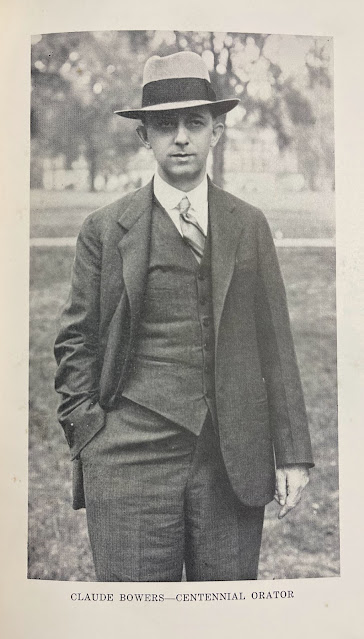In 2019 I wrote a blog post about Alabama's 1919 statehood centennial celebrations. One of the featured items was a commemorative half-dollar coin issued by the U.S. Mint. In this post I wanted to delve a bit deeper into that coin's history.
The state legislature created the Alabama Centennial Commission in February 1919. Governor Thomas Kilby, inaugurated just the month before, became Chairman, and Marie Bankhead Owen, a well known figure in archival and historical circles, was named Secretary and Historian. She was the author of several plays and publications related to the centennial.
The Commission asked U.S. Representative Lilius Bratton Rainey to introduce a bill in Congress calling for a commemorative coin to be issued. Rainey was on the board of directors of the state archives and thus known to both Marie Owen and her husband Thomas, state archivist. Congress passed the bill which was signed by President Wilson on May 10, 1920. The Wikipedia entry on the half-dollar has a detailed account of the legislative history.
Gov. Kilby then created a three-member committee to come up with a design. Public input was accepted, but all of those suggestions were rejected. Kilby then recommended to the director of the mint a coin that would have the state capitol building on one side and James Monroe, president in 1819 when Alabama was admitted to the Union, and Woodrow Wilson on the other. The capitol building was rejected, and the seal of Alabama suggested as a substitute.
In November 1920 Republican Warren Harding defeated Wilson in the presidential election. Owen then proposed the faces of Kilby and first governor William Wyatt Bibb. This substitution solved the problem of a Democrat on a coin issued by a Republication administration, and if Harding was added, a Republican president on a coin honoring strongly Democratic Alabama.
At this point James Earle Fraser, a sculptor who had designed the Buffalo nickel and a member of the U.S. Commission on Fine Arts, suggested that his wife Laura Gardin Fraser, also a sculptor, create the final design. In September 1921 she delivered her version, and the U.S. Mint then issued the coin from its Philadelphia facility, although the coin has no mint mark.
Some 5000 of the coins were issued with a "2x2" mark added since Alabama had been the 22nd state admitted to the Union. A large number of "plain" coins, 64,038, were also struck. Five thousand of those "plain" ones were eventually returned to the mint and melted.
President Harding journeyed to Birmingham for the initial sale on October 26, 1921, nearly two years after the end of the centennial year. The commemorative coins cost one dollar each and were sold from special booths constructed along the streets downtown. Harding spoke on race relations to the segregated crowd. While in the city he also laid the cornerstone for a new Masonic temple. Harding had arrived on October 24 and most of his visit revolved around the city's semi-centennial.
This coin proved to be important in the history of American coinage. The half-dollar was the first U.S. coin to feature a living individual and the first to be designed by a woman. One of the plain coins in excellent condition sold in 2014 for over $7300.
Laura Fraser [born in Chicago on September 14, 1889, died August 13, 1966] designed not only coins and medals, but also created large sculptures. An example in Baltimore features Robert E. Lee and Stonewall Jackson and has been controversial in recent years.
Alabama's first governor was William Wyatt Bibb [October 2, 1781-July 10, 1820] who served 1819-1820. He had held political offices in Georgia before appointment by President James Monroe as Governor of the newly-created Alabama Territory in 1817.
Thomas E. Kilby [July 9, 1865-October 22, 1943] was governor 1919-1923. One of his progressive efforts was to improve prison conditions. The state's new prison which opened in 1922 was named after him and operated until demolished in 1970. Kilby was a successful businessman in Anniston who also ran for the U.S. Senate twice but was defeated by Hugo Black both times.
Thomas E. Kilby's official portrait
Source: Encyclopedia of Alabama
Portrait of William Wyatt Bibb
Source: Encyclopedia of Alabama









































